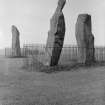Field Visit
Date 18 August 1925
Event ID 1099003
Category Recording
Type Field Visit
Permalink http://canmore.org.uk/event/1099003
Standing Stones, Lundin Links.
On the north side of the roadway about 400 yards north of the railway station at Lundin Links, on a slightly elevated plateau, which forms part of a golf course, are three tall, unsculptured, and irregularly shaped pillars of red sandstone known as the Standing Stones of Lundin. The New Statistical Account (1) records that "ancient sepukhres are found near them," and they are sometimes spoken of as the burial stones of Danish chiefs. The three surviving stones - for a fourth is known to have been inexistence towards the close of the 18th century - are set in the form of a triangle, the angles of which would fall very evenly upon the circumference of a circle with a diameter of 54 feet. In all probability, therefore, they are the remains of a Stone Circle. Each of them has been packed at the base with a setting of small stones. Although it is not the highest, the one on the south-east, which stands with a slight inclination towards the north and the east, presents the most massive appearance. The girth at the base is 12 feet 8 inches, but measurements taken at 5 feet from the ground give the following dimensions: north face, 5 feet 2 inches; south face, 5 feet; east face, 1 foot 11 inches; west face, 2 feet 2 inches; girth, 14 feet 3 inches; and the stone becomes even wider as its height increases, until near the top where it again shrinks to a very slightly rounded extremity. The height is approximately13 feet 6 inches. The surface is pitted by the action of the weather and shows greatest traces of decay on the east, where a crack has developed. The south stone is set with a decided inclination towards the south. It is of very irregular form with a girth at the base of 9 feet 4 inches, expanding to 10 feet at 5 feet higher up, and suddenly becoming greatly attenuated at the top. The stone, which does not exhibit the same noticeable traces of weathering as the one first described, is approximately 17 feet high. The north stone, which is set with a slight inclination towards the west, appears to be still taller. It rises to a height estimated at 18 feet and has a sharply pointed top. It shows evidence of weathering at the north-west corner. Like the others, it increases in bulk from the base upwards to the middle of its height, the girth being 9 feet 6 inches at the base, and 10 feet 2 inches at 5 feet up. See Proc. Soc. Ant. Scot., xxxvii (1902-3), pp. 212-15.
RCAHMS 1933, visited 18 August 1925.
(1) Vol. ix, p. 438, 1837.xxi S.W.









